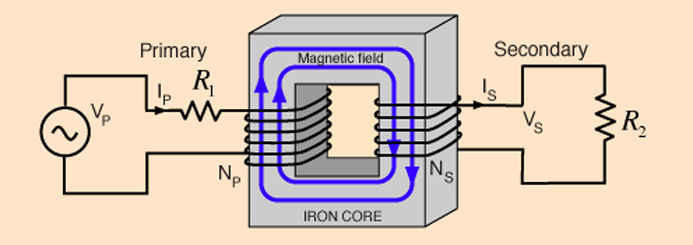What is a Primary Circuit?
The primary circuit refers to the input section of an isolated power supply, which is connected to the AC mains. This section of the power supply has dangerous voltage levels and not designed to be directly accessed by users.
In a majority of power supplies, the primary circuit starts at the mains input and end at the primary winding of the transformer. The transfer of energy from the primary side to the secondary side happens when the alternating current induces in the primary winding of the transformer induces an EMF in the secondary winding. The amount of energy transferred depends on the transformer turns ratio and the wire thickness. The ratio refers to the number of the primary winding to the number of secondary winding.
Basic primary and secondary transformer circuit – Image Credit
In most cases the secondary has fewer turns than the primary, hence lower voltage is available at the secondary compared to the primary. However, some circuits such as extra high voltage applications such as a CRT tube supply has more secondary turns which make the flyback transformer to produce several kilovolts.
Primary in dc-ac power inverter
In AC mains applications, the primary circuits start from the ac power input, and will basically include a fuse, surge protectors, a rectifier, tank capacitors and then the transformer primary for a linear converter. However, an SMPS has additional components, including an oscillator, inverter, and switching device. In addition, the inverter output is usually at a higher frequency of about 50 kHz compared to the mains supply frequency of 50 or 60 Hz. The high frequencies require smaller transformers and have lower losses.
In battery operated circuits with internal power supplies or external inverters such those used with solar power systems, the primary circuit refers to the part before the transformer. However, in this case, a step up transformer is used to increase the voltage from the 12 Volts DC and output 120 or 240 Volts DC.
Transformer primary and secondary windings
In a majority of the power supplies, whether linear or switch mode power supplies, the transformer performs the following two functions.
- Lowering the mains supply voltage
- Providing isolation between the mains and the circuit to be powered by the supply.
The transformer uses magnetic induction to transfer the power from the primary side to the secondary side and there is no direct physical connection between the two circuits, hence the isolation. An SMPS must have feedback from the secondary to the primary circuit. This allows the inverter to adjust and maintain a stable output. The design uses opto-coupler isolators to provide feedback through light signals, hence preventing any physical contact between the secondary and the primary.
